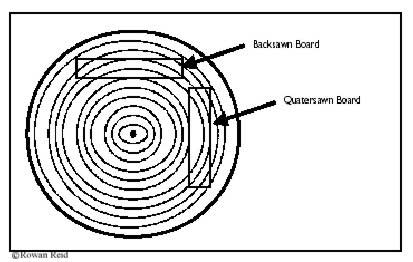|
|
|
Backsawn and quartersawn
Backsawn and quartersawn are the terms
used to describe the methods mills use to cut boards. Each
sawing pattern gives a different appearance, especially in
species with prominent rays or interlocking grain. The preferred
method will depend on the species, product preferences and
sawing equipment.
The diagram below illustrates the difference between backsawn
and quartersawn boards. Backsawn boards are cut so that the
faces of the board are roughly tangential to the annual growth
rings. In practice, timber is regarded as backsawn if the
growth rings meet the face of the board at an angle of less
than 45 degrees. Backsawing often allows for a higher recovery
from small diameter or pruned logs, although backsawn boards
may be less stable in drying.
Boards are quartersawn when the sawn boards are cut so that
the face shows the vertical lines of the growth rings. Quartersawn
timber has several advantages including:
• reduced shrinkage and cupping during drying
• reduced reaction to moisture changes when in use
• easier reconditioning of boards from species prone
to collapse.
Each sawing pattern gives a different appearance especially
in species with prominent rays or interlocking grain. Backsawn
boards are commonly preferred for use in furniture because
the growth rings are less prominent than in quatersawn boards.

Back to top
 |
|
|
|
